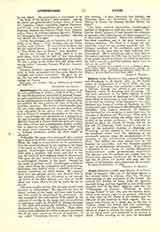

Auenbrugger (or VON AUENBRUGG), LEOPOLD, an Austrian physician, b. November 19, 1722; d. May 17, 1807. He was the inventor of percussion in physical diagnosis and is considered one of the small group of men to whose original genius modem medicine owes its present position, He was a native of Graz in Styria, an Austrian province. His father, a hotel-keeper, gave his son every opportunity for an excellent preliminary education in his native town and then sent him to Vienna to complete his studies at the university. Auenbrugger was graduated as a physician at the age of twenty-two and then entered the Spanish Military Hospital of Vienna where he spent ten years. His observations and experimental studies enabled him to discover that by tapping on the chest with the finger much important information with regard to diseased conditions within the chest might be obtained.
Ordinarily, the lungs when percussed, give a sound like a drum over which a heavy cloth has been placed. When the lung is consolidated, as in pneumonia, then the sound produced by the tapping of the finger is the same as when the fleshy part of the thigh is tapped. Auenbrugger found that the area over the heart gave a modified, dull sound, and that in this way the limits of heart-dullness could be determined. This gave the first definite information with regard to pathological changes in the heart. During his ten years of patient study, Auenbrugger confirmed these observations by comparison with post-mortem specimens, and besides made a number of experimental researches on dead bodies. He injected fluid into the pleural cavity, and showed that it was perfectly possible by percussion to tell exactly the limits of the fluid present, and thus to decide when and where efforts should be made for its removal.
His later studies during this ten-year period were devoted to tuberculosis. He pointed out how to detect cavities of the lungs, and how their location and size might be determined by percussion. He also recognized that information with regard to the contents of cavities in the lungs, and the conditions of lung tissue might be obtained by placing the hand on the chest and noting the vibration, or fremitus, produced by the voice and the breath. These observations were published in a little book now considered one of the most important classics of medicine. It was called “Inventum Novum”, the full English title running, “A New Discovery that Enables the Physician from the Percussion of the Human Thorax to Detect the Diseases Hidden Within the Chest”.
Like most medical discoveries, Auenbrugger’s method of diagnosis at first met with neglect. Before his death, however, it had aroused the attention of Laennec, who, following up the ideas suggested by it, discovered auscultation. Since then, Auenbrugger has been considered one of the great founders of modern medicine. He lived to a happy old age, especially noted for his cordial relations with the younger members of his profession, and for his kindness to the poor and to those suffering from tuberculosis. He is sometimes said to have died in the typhus epidemic of 1798, but the burial register of the parish church in Vienna, of which he had been for half a century a faithful member, shows that he did not die until 1807.
JAMES. J. WALSH

